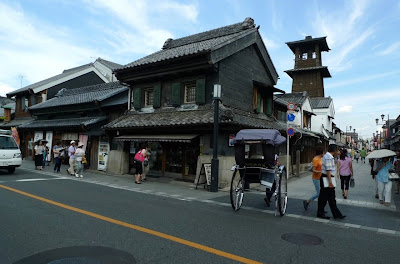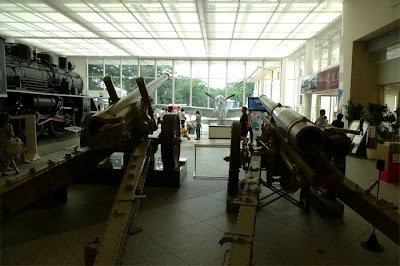Museum Visits
Tokyo National Museum (東京国立博物館) at Ueno
Park.
The Japanese Gallery looks dated and does not have a great depository of its national arts as anticipated. Comparatively speaking, the collections in Asian Gallery on right is richer in quality and better by display. I happened to miss out on The Gallery of Horyuji Treasure (法隆寺宝物館), which is positively smaller but nicely contemporary in design. This gallery and the Museum Garden (with restored Edo timber buildings) would justify a revisit to Ueno Park.
The Gallery of Horyuji Treasure on left and
Museum Garden on
right. (images∣www.resonate.co.nz and www.sunlaushi.exblog.jp)
The latter with tea houses is open for two periods of time in spring and autumn only.
Three-storey
Asian Gallery with artefacts spanning from the Orient to the Middle-East.
Stone sculptures and relief works dominate the venue.
Tang dynasty pottery figures remind one of the Star Wars
princesses.
Rare collections of Egyptian and Mesopotamian art are present.
American pop art and photographs by Andreas Gursky were on show
at the Tokyo National Art Center (国立新美術館) in Roppongi. Having seen in other places, I skipped both to lunch at Brasserie Paul
Bocuse Le Musee on one of the giant drums and acclaimed locally as a
value-for-money establishment.
The foyer is packed with three restaurants and café, cutlery clanking fills the high ceiling.
The museum entrance has the impression of a trendy hotel lobby.
Seductive curves of the external wall summarize this work by
Kisho Kurokawa (黑川纪章, 1934-2007).
Passed
Aoyama Prada in a leafy neighbourhood is the Nezu Museum (根津美術館). The little custodian of oriental arts was
completely remodeled by Kengo Kuma (隈研吾)
in 2009 after the initial opening in 1940.
The foyer
overlooking the garden.
The building is deceptively simple in design. Yet it is loaded with values underscoring Japanese design philosophy - simplicity of expression and efficiency of use.
The clever
use of real bamboo shoots screens the site away from the busy traffic outside. The resulting long possession towards the lobby allows people to prepare for the mood of museum visit.
My flight
schedule prevented me from a proper visit of the museum.
Floor
plan showing the revered café nestled in
garden setting. (image∣www.architecturalrecord.com)
garden setting. (image∣www.architecturalrecord.com)
As the terminating point of the fashion walk along Omotesando, Nezu would make up a peaceful winding-down of any visit schedule.
Kawagoe (川越)
This small town of 30-minute journey from Ikebukuro
Railway Station retains the old charms that has disappeared in down-town Tokyo, hence the affectionate
name of “Little Edo”. Despite the fact
that most buildings are replicated from the past, the time-honoured urban
fabric is preserved. The Tower of Bell, initially constructed for fire
warning, tells the time once every fifteen minutes.
Amid tourist trails, there are genuine domestic neighbourhoods
around.
The traditional Japanese house is where the architectural influences
of the Tang yynasty (618-906) from China remain traceable. It had been revealed that the US government
consulted the Chinese architectural scholar Leong Si-cheng (梁思成, 1901-1972) prior to the massive raids of Japan towards
the end of WWII. Leong advised that Nara
(奈良) and Kyoto (京都) be spared due to the fact
that its existing architectural heritage even surpassed those remained in
China.
Thriving street life and interesting shops abound.
People, in formal attire, paying respect to shrines at the
famous Youjyuin Temple (養寿院).
Buddha with serene gaze at the cemetery of the temple.
Observe the beautiful piece of paper weight on free booklets for visitors. This unguarded snake ornament would have been
pinched in most countries.
Country
at Crossroads
Amid the economic downturn from the 1990s up to now, the
Japanese government has tried various fiscal policies to dig themselves out
from what is known as The Lost Decades (失われた20年 Ushinawareta Nijunen).
One of them is the bidding and eventual selection to
host the 2020 Summer Olympics. Will this
city, indeed the whole country, get out of the dogged recession and go through
another economic miracle just as it did half a century ago?
Understanding the People
Without actual fieldwork at the time, much of Ruth Benedict’s distant anthropological work The Chrysanthemum
and The Sword, 1946 is still relevant.
Distance is relative, being near does not automatically imply that one has a clear
understanding of things. On this occasion, photographic narratives are correlated as impressions for
readers.
Beauty and cosmetics are huge businesses here, the alternative pedicure
massage at the entertainment district of Kabukicho (歌舞技町) offers a quiet spectacle.
The
Japanese sense of aesthetics and attention to detail can be overwhelming. In this instance the shop sign (framed at centre) of an unassuming gift retailer was the kind of laconic composition that
impressed me when I studied graphic art years ago.
Sushi-making has quintessentially the virtue of dedication
wrapped within. A proper chef often
has to go through years of apprenticeship before starting to learn the trade proper. The traditional way is that most people would
stay in one business and earn their time-honoured expertise.
It is quite unlike Stephanie Key, the daughter of the New
Zealand Prime Minister and an art student, who manages to shoot to fame in no
time by posing as sushi-on-naked-flesh (女体盛 nyotaimori) for
her photographic show in Paris Design Week in September. (image∣www.dailymail.co.uk)
The Japanese zeal for outsmarting nature can be admirable but at
times intimidating such as their humanoid robot technology.
Fresh fruits grown in this country can command tens of dollars(US) a
piece. The fruits photographed here,
completely artificial but tasty anyhow, are usually presented as novel gifts.
If the molesting giant monsters from the film “Pacific Rim” prove
to be too hard to swallow for fit minds, the wholesale obsession with kaiju
(literally “strange beasts”) is much to be found in film, TV, comics, and
toys. This institutionalized attachment is
deeply rooted in the modern Japanese psyche.
The preoccupations with great disaster and impending destruction,
whether to do with the perennial threats of earthquakes and experiences of atomic bombs, have been elevated to the level of totem worship. The kaiju characters, collective
embodiment of such obsession, are simultaneously feared and worshipped.
The antagonist of monsters – Ultraman Ginga is celebrating
his 45th anniversary of busting villains this year.
Japan Sinks (the English translation of 日本沉沒)
by Sakyo
Komatsu (小松左京, 1931-2011).
No country is more obsessed than Japan when it comes to doomsday paranoid. The book, spun off with TV drama, film releases in 1973 and 2006, has a cult following since its publication in 1973. Flashes of the old film still remain intact in my mind.
It is said that the annual revenue drawn from pachinko
business is bigger than the car industry in Japan. The popularity of these steel balls is a
legendary myth to gaijin (foreigners). Perhaps it takes one obsession to fend off
other obsessions. Most joints are
operated by yakuza gangs and photo-taking remains off-limits.
These cosplay gears were not photographed in a sex shop but superstore admittable to all. They are an extension of the addictions to manga (comics) and anime (cartoon). The
costumes are accepted by all walks of life and are seen worn night and day. Kinky, risqué, kitsch or corny are no words to
label this phenomenon.
In contrast, enduring hardship as portrayed in this bronze
arhat monk is buried deep in the collective psyche.
The same attitude of endurance is expected of in real life –
in this photograph, scores of participants bathed in icy water at the Teppozu
Inari Shrine (鉄砲洲稻荷神社), Tokyo to purify their souls. (image/www.ansa.it)
War and Peace
The Tomb
of the Shogitai Warriors (彰義隊墓所) at Ueno Park says: “At the fall of the
Shogunate Government in Edo, Shogitai warriors resisted the new Meiji
Government to the last and died here on Ueno Hill”. Even though the Meiji is unequivocally regarded
as the government that lift Japan into the modern world, no samurai, whatever
their cause, would be forgotten had they done honour to the country. This no-surrender mentality is a double-edged
sword of pride to themselves but incomprehension to others.
Right-wing militant groups at Yasukuni Jinja Shrine (靖國神社) commemorating the 68th anniversary of atomic
bombing in Hiroshima on the 8 August.
The whole parade was intense to the effect that there was
complete dead-air and everyone stood aside to watch.
The large shrine is where the Japanese WWII dead soldiers are
worshipped. They include those who were
classified as Class-A war criminals by the Allied judges of the Tokyo Trials
after the war. Protests in many Asian countries are fervent whenever the Japanese government officials esp. the prime minister
visits the shrine. This is the background of my visit to the temple.
Deep in the compound of the shrine is Yushukan (War Museum)
exhibiting Japanese arsenal and their version of military aggressions in Asia from the 1890s to
1945. Foreign visitors may not notice
this plain-looking establishment but this is the place to see the shadow - in Jungian terms the unconscious, which gives light to the
conscious.
Apart from the killing machines, a train engine on display
paints the story of economic contributions to Thailand and Burma during the war
years. Tens of thousands of POWs and
civilians from Asia and the west were forced to work and died during
the construction of the so-called ‘death railway’. (The Bridge on the River
Kwai and more recently The Railway Man retrace the stories on the wide screen.)
The works was presented as a local contribution in the ‘Greater Asia Co-Prosperity
Sphere’ unilaterally imposed by Japan to other Asian
countries. This museum, reflecting so different in
attitude to those in Germany, is designed to justify a colossal mistake than to
provide lessons for the future.
New developments of the city across Tokyo Bay.
In the context of persistent economic downturn, jitters with neighbouring countries and constitutional reform of the military, it is in everyone’s concern to see what direction Japan is heading.










































No comments:
Post a Comment